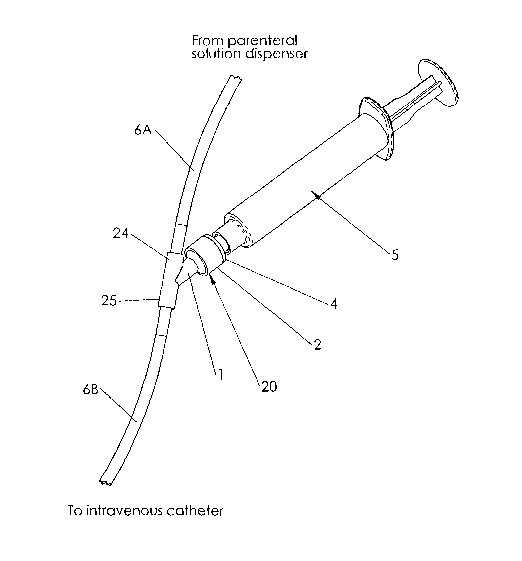Some of the information on this Web page has been provided by external sources. The Government of Canada is not responsible for the accuracy, reliability or currency of the information supplied by external sources. Users wishing to rely upon this information should consult directly with the source of the information. Content provided by external sources is not subject to official languages, privacy and accessibility requirements.
Any discrepancies in the text and image of the Claims and Abstract are due to differing posting times. Text of the Claims and Abstract are posted:
| (12) Patent Application: | (11) CA 2585246 |
|---|---|
| (54) English Title: | MEDICAL CONNECTOR |
| (54) French Title: | CONNECTEUR MEDICAL |
| Status: | Deemed Abandoned and Beyond the Period of Reinstatement - Pending Response to Notice of Disregarded Communication |
| (51) International Patent Classification (IPC): |
|
|---|---|
| (72) Inventors : |
|
| (73) Owners : |
|
| (71) Applicants : |
|
| (74) Agent: | NORTON ROSE FULBRIGHT CANADA LLP/S.E.N.C.R.L., S.R.L. |
| (74) Associate agent: | |
| (45) Issued: | |
| (86) PCT Filing Date: | 2005-01-24 |
| (87) Open to Public Inspection: | 2006-05-04 |
| Availability of licence: | N/A |
| Dedicated to the Public: | N/A |
| (25) Language of filing: | English |
| Patent Cooperation Treaty (PCT): | Yes |
|---|---|
| (86) PCT Filing Number: | PCT/US2005/002259 |
| (87) International Publication Number: | WO 2006046961 |
| (85) National Entry: | 2007-04-24 |
| (30) Application Priority Data: | ||||||
|---|---|---|---|---|---|---|
|
A needleless connector for adding medication to a parenteral fluid is
provided. The needless connector comprises a connector (1) adapted to receive
a syringe (5) and having a check valve to seal the port in place of a puncture
pad. The check valve comprises a resilient disc (13) held in place and biased
closed by the tensile stress of the check valve material. When a syringe or
other apparatus having a male luer connector (14) is engaged with the
connector and fluid pressure is applied to the check valve the resilient disc
is deformed which allows the medication to flow through the connector into the
tubing and thus to the patient.
L'invention concerne un connecteur sans aiguille qui permet d'ajouter un médicament à une solution parentérale. Ce connecteur sans aiguille comprend un connecteur conçu pour recevoir une seringue et comprenant un clapet de non-retour permettant de sceller l'orifice à la place d'un tampon à percer. Le clapet de non-retour comprend un obturateur souple maintenu et sollicité par la contrainte de traction du matériau du clapet de non-retour. Lorsqu'une seringue ou un autre appareil pourvu d'un connecteur Luer mâle est raccordé avec le connecteur et que la pression fluidique est appliquée au clapet de non-retour, l'obturateur souple est déformé, ce qui permet au médicament de s'écouler dans le tube puis dans le patient à travers le connecteur.
Note: Claims are shown in the official language in which they were submitted.
Note: Descriptions are shown in the official language in which they were submitted.

2024-08-01:As part of the Next Generation Patents (NGP) transition, the Canadian Patents Database (CPD) now contains a more detailed Event History, which replicates the Event Log of our new back-office solution.
Please note that "Inactive:" events refers to events no longer in use in our new back-office solution.
For a clearer understanding of the status of the application/patent presented on this page, the site Disclaimer , as well as the definitions for Patent , Event History , Maintenance Fee and Payment History should be consulted.
| Description | Date |
|---|---|
| Application Not Reinstated by Deadline | 2010-01-25 |
| Time Limit for Reversal Expired | 2010-01-25 |
| Deemed Abandoned - Failure to Respond to Maintenance Fee Notice | 2009-01-26 |
| Inactive: Office letter | 2008-07-28 |
| Revocation of Agent Requirements Determined Compliant | 2008-07-24 |
| Appointment of Agent Requirements Determined Compliant | 2008-07-24 |
| Appointment of Agent Request | 2008-04-15 |
| Revocation of Agent Request | 2008-04-15 |
| Inactive: Adhoc Request Documented | 2008-03-07 |
| Inactive: Correspondence - Transfer | 2007-12-18 |
| Inactive: Correspondence - Transfer | 2007-12-18 |
| Inactive: Declaration of entitlement - Formalities | 2007-07-23 |
| Inactive: Incomplete PCT application letter | 2007-07-10 |
| Inactive: Cover page published | 2007-07-09 |
| Inactive: Notice - National entry - No RFE | 2007-07-05 |
| Inactive: First IPC assigned | 2007-05-16 |
| Application Received - PCT | 2007-05-15 |
| National Entry Requirements Determined Compliant | 2007-04-24 |
| Application Published (Open to Public Inspection) | 2006-05-04 |
| Abandonment Date | Reason | Reinstatement Date |
|---|---|---|
| 2009-01-26 |
The last payment was received on 2007-12-04
Note : If the full payment has not been received on or before the date indicated, a further fee may be required which may be one of the following
Please refer to the CIPO Patent Fees web page to see all current fee amounts.
| Fee Type | Anniversary Year | Due Date | Paid Date |
|---|---|---|---|
| MF (application, 2nd anniv.) - standard | 02 | 2007-01-24 | 2007-04-24 |
| Basic national fee - standard | 2007-04-24 | ||
| MF (application, 3rd anniv.) - standard | 03 | 2008-01-24 | 2007-12-04 |
Note: Records showing the ownership history in alphabetical order.
| Current Owners on Record |
|---|
| ROWAN P., JR. SMITH |
| Past Owners on Record |
|---|
| LISA M. FITZGERALD |